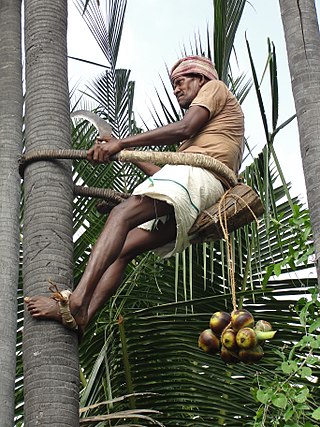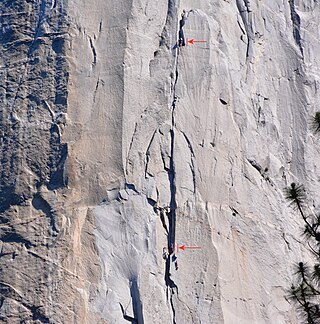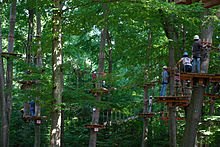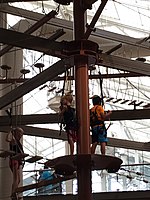
Tree climbing is a recreational or functional activity consisting of ascending and moving around in the crowns of trees.

Glossary of climbing terms relates to rock climbing, mountaineering, and to ice climbing.

Rock-climbing equipment varies with the type of climbing undertaken. Bouldering needs the least equipment outside of shoes and chalk and optional crash pads. Sport climbing adds ropes, harnesses, belay devices, and quickdraws to clip into pre-drilled bolts. Traditional climbing adds the need for carrying a "rack" of temporary passive and active protection devices. Multi-pitch climbing adds devices to assist in ascending and descending fixed ropes. And finally aid climbing uses unique equipment.

Abseiling, also known as rappelling, is the controlled descent of a steep slope, such as a rock face, by moving down a rope. When abseiling, the person descending controls their own movement down the rope, in contrast to lowering off, in which the rope attached to the person descending is paid out by their belayer.

Belaying is a variety of techniques climbers use to create friction within a climbing system, particularly on a climbing rope, so that a falling climber does not fall very far. A climbing partner typically applies tension at the other end of the rope whenever the climber is not moving, and removes the tension from the rope whenever the climber needs more rope to continue climbing.

In climbing, a pitch is a section of a climbing route between two belay points, and is most commonly related to the task of lead climbing, but is also related to abseiling. Climbing on routes that require only one pitch is known as single-pitch climbing, and climbing on routes with more than one pitch is known as multi-pitch climbing.

Rock climbing is a sport in which participants climb up, across, or down natural rock formations or indoor climbing walls. The goal is to reach the summit of a formation or the endpoint of a usually pre-defined route without falling. Rock climbing is a physically and mentally demanding sport, one that often tests a climber's strength, endurance, agility and balance along with mental control. Knowledge of proper climbing techniques and the use of specialized climbing equipment is crucial for the safe completion of routes.
Kernmantle rope is rope constructed with its interior core protected by a woven exterior sheath designed to optimize strength, durability, and flexibility. The core fibers provide the tensile strength of the rope, while the sheath protects the core from abrasion during use. This is the only construction of rope that is considered to be life safety rope by most fire and rescue services.
An assault course is a trail that combines running and exercising. It was more popular in the 1970s than it is now. It is often used in military training. The prime use is to evaluate progress and weaknesses of the individual or the team involved. The term Assault Course can be replaced by Obstacle Course, which some view as more accurate. Confidence Courses is another term used. There are also specific Urban Obstacle Courses and Night Obstacles Courses. An Obstacle Course Race (OCR) is a civilian sporting and fitness challenge event which combines obstacles and cross country running.
An obstacle course is a series of challenging physical obstacles an individual, team or animal must navigate, usually while being timed. Obstacle courses can include running, climbing, jumping, crawling, swimming, and balancing elements with the aim of testing speed, endurance and agility. Sometimes a course involves mental tests. The idea has been adapted into TV shows and video games.

A climbing rope is a rope that is used in climbing. It is a critical part of an extensive chain of protective equipment used by climbers to help prevent potentially fatal fall-related accidents.

A dynamic rope is a specially constructed, somewhat elastic rope used primarily in rock climbing, ice climbing, and mountaineering. This elasticity, or stretch, is the property that makes the rope dynamic—in contrast to a static rope that has only slight elongation under load. Greater elasticity allows a dynamic rope to more slowly absorb the energy of a sudden load, such from arresting a climber's fall, by reducing the peak force on the rope and thus the probability of the rope's catastrophic failure. A kernmantle rope is the most common type of dynamic rope now used. Since 1945, nylon has, because of its superior durability and strength, replaced all natural materials in climbing rope.

A belay device is a mechanical piece of climbing equipment used to control a rope during belaying. It is designed to improve belay safety for the climber by allowing the belayer to manage their duties with minimal physical effort. With the right belay device, a small, weak climber can easily arrest the fall of a much heavier partner. Belay devices act as a friction brake, so that when a climber falls with any slack in the rope, the fall is brought to a stop.

Go Ape! is an outdoor adventure company which runs tree top ropes courses under the names Tree Top Challenge, Tree Top Adventure and Zip Trekking, as well as ground-based Forest Segway Safaris, at locations across the United Kingdom and the United States.

An adventure park is a place which can contain a wide variety of elements, including but not limited to, rope climbing exercises, obstacle courses, bouldering, rock climbing, target oriented activities, and zip-lines. They are usually intended for recreation.
Project Adventure is an international nonprofit education organization based in Beverly, Massachusetts. The mission of Project Adventure is to provide leadership in the expansion of adventure-based experiential programming.
The Special Operations Training Group, or SOTG, is a training section of the United States Marine Corps providing Marine Expeditionary Force (MEF) commanders with training facilities and a liaison for Marine Expeditionary Units (MEU). The SOTG provides special operations training for various branches and also participates in the MEUs' Special Operations Capable Certification by acting as the "Training and Evaluation Board" for the exercises and events during the MEU annual training cycles.

Mega Adventure Park - Singapore is located on the picturesque Sentosa Island, host to Singapore’s main attractions. The park operates world famous MegaZip flying fox, spanning 450m, flying at 60 km/hour, over the island's jungles and beaches. There are 3 additional activities, a 36-obstacle treetop ropes course (MegaClimb), a 15m free fall simulator (MegaJump) and a dynamic bungee assisted trampolines (MegaBounce).

Caving equipment is equipment used by cavers and speleologists to aid and protect them while exploring caves. The term may also be used to refer to equipment used to document caves, such as photographic and surveying equipment. Originally, cave diving equipment was quite limited, but the increasing popularity of caving during the 20th century led to the creation of specialist caving equipment and companies.






















